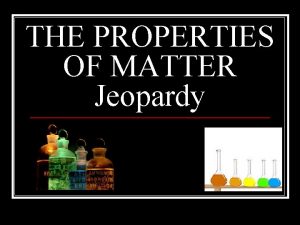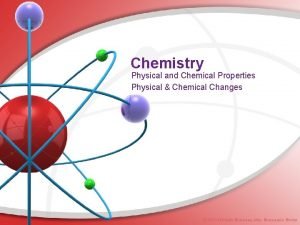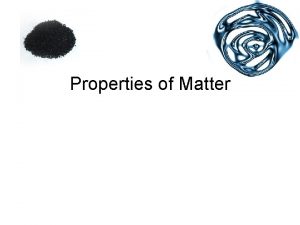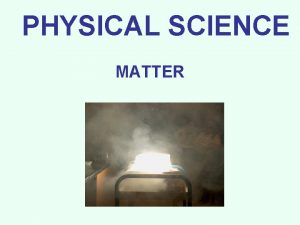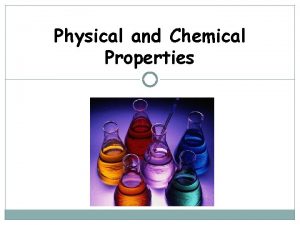Physical Properties of Matter Matter Matter is anything







- Slides: 7

Physical Properties of Matter

Matter �Matter is anything that has mass and takes up space. �It includes all the physical “stuff” around us— rocks, houses, water, air, people, ants, trees, etc. �All matter can exist as a solid, a liquid, or a gas. �Matter includes all the things we can mass (to find the mass) and measure to find the volume (because they take up space).

Describing Matter Different substances—different types of matter—have different properties that can be used to distinguish them from each other. � These properties are things that you can observe or measure about the substance. � For example, water and isopropyl alcohol (rubbing alcohol) are both clear, colorless liquids at room temperature. However, they can be told apart because they have other properties that are different. Water is odorless while the isopropyl alcohol has a strong smell. The alcohol evaporates very quickly while the water evaporates slowly. Also, the alcohol is flammable—it can be set on fire with a match (but don’t try this at home!). Water, on the other hand, is not only inflammable; it is used to put out fires. �

Properties to Describe Matter � The properties of matter can be divided into two categories: physical properties and chemical properties. � Physical properties can be observed or measured without changing the composition of the substance. � An example is odor. When you smell water or isopropyl alcohol, neither of these substances changes into something else. They remain water and isopropyl alcohol. Similarly, when water and isopropyl alcohol evaporate, they do not change into something else. They move from liquid into gas, but the water is still water and the alcohol is still alcohol. Because these substances do not change into different substances, the properties of odor and speed of evaporation are physical properties.

Physical Properties �Physical properties can be observed or measured without changing the composition of matter. Physical properties are used to observe and describe matter. �There are two different types of physical properties: intensive and extensive

Intensive Physical Properties Intensive - Properties that do not depend on the amount of the matter � present. ▪ Color ▪ Odor ▪ Luster - How shiny a substance is. ▪ Malleability - The ability of a substance to be beaten into thin sheets. ▪ Ductility - The ability of a substance to be drawn into thin wires. ▪ Conductivity - The ability of a substance to allow the flow of energy or electricity. ▪ Hardness - How easily a substance can be scratched. ▪ Melting/Freezing Point - The temperature at which the solid and liquid phases of a substance are in equilibrium at atmospheric pressure. ▪ Boiling Point - The temperature at which the vapor pressure of a liquid is equal to the pressure on the liquid (generally atmospheric pressure). ▪ Density - The mass of a substance divided by its volume

Extensive Physical Propertires Extensive - Properties that do depend on the amount of matter present. ▪ Mass - A measurement of the amount of matter in a object (grams). ▪ Weight - A measurement of the gravitational force of attraction of the earth acting on an object. ▪ Volume - A measurement of the amount of space a substance occupies. ▪ Length

